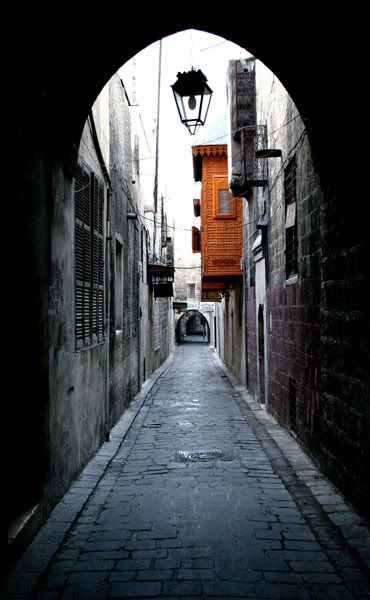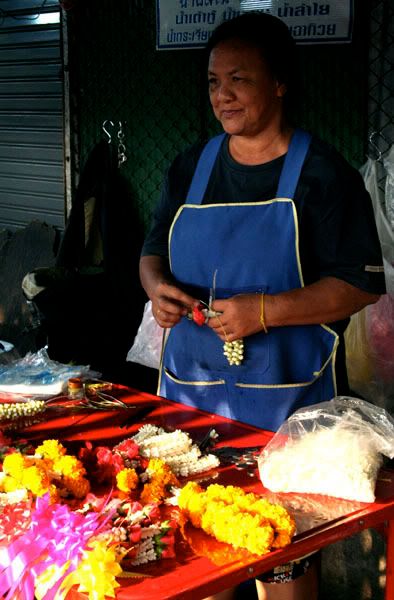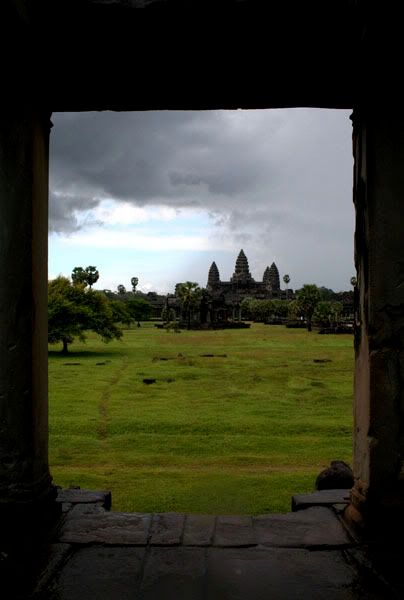 By the time you read this, we'll likely be on our way to Cambodia -- or if we're lucky, we'll have arrived in Siem Reap, and be enjoying a dry cocktail on a shaded veranda. I've wanted to to return to Cambodia for months, almost since the moment I left. Hopefully I'll be updating soon with notes on jungle-clad temples, subtly flavored Khmer food, and refreshing Phnom Penh cafes.
By the time you read this, we'll likely be on our way to Cambodia -- or if we're lucky, we'll have arrived in Siem Reap, and be enjoying a dry cocktail on a shaded veranda. I've wanted to to return to Cambodia for months, almost since the moment I left. Hopefully I'll be updating soon with notes on jungle-clad temples, subtly flavored Khmer food, and refreshing Phnom Penh cafes.
Wednesday, April 30, 2008
Revenez au Cambodge.
 By the time you read this, we'll likely be on our way to Cambodia -- or if we're lucky, we'll have arrived in Siem Reap, and be enjoying a dry cocktail on a shaded veranda. I've wanted to to return to Cambodia for months, almost since the moment I left. Hopefully I'll be updating soon with notes on jungle-clad temples, subtly flavored Khmer food, and refreshing Phnom Penh cafes.
By the time you read this, we'll likely be on our way to Cambodia -- or if we're lucky, we'll have arrived in Siem Reap, and be enjoying a dry cocktail on a shaded veranda. I've wanted to to return to Cambodia for months, almost since the moment I left. Hopefully I'll be updating soon with notes on jungle-clad temples, subtly flavored Khmer food, and refreshing Phnom Penh cafes.
Monday, April 28, 2008
Vietnamese drip.
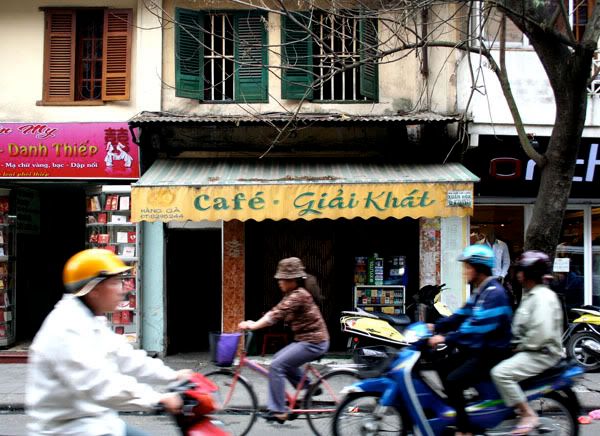 Sitting on low wooden stools in a smoky interior, we watch the door for our waitress. Across from us, two college students play chess, alternating moves on the board with long slow sips from the glasses perched on the edge of the table. Next to us, a young mother chats happily with her friends, pausing briefly to mind her young daughter as she buzzes around them in boredom. Finally, our waitress climbs over the threshold of the stairs, a tray held firmly level in her hands. She lowers down to our table, and sets out our order. Two short glasses of dark, rich Vietnamese drip coffee, resting on a cushion of creamy condensed milk. We stir it together, the viscous milk hesitating before swirling lethargically into dark brew.
Sitting on low wooden stools in a smoky interior, we watch the door for our waitress. Across from us, two college students play chess, alternating moves on the board with long slow sips from the glasses perched on the edge of the table. Next to us, a young mother chats happily with her friends, pausing briefly to mind her young daughter as she buzzes around them in boredom. Finally, our waitress climbs over the threshold of the stairs, a tray held firmly level in her hands. She lowers down to our table, and sets out our order. Two short glasses of dark, rich Vietnamese drip coffee, resting on a cushion of creamy condensed milk. We stir it together, the viscous milk hesitating before swirling lethargically into dark brew.Now, I’m sorry, Thailand. I know you have great bag coffee, and hill-tribe grown arabica, and even a fairly decent local chain in Black Canyon- but the best coffee in Southeast Asia is undoubtedly in Vietnam.
 Vietnamese coffee is well known, not just for the quality of its French-introduced beans, but also for its unique form of preparation. Ground coffee is spooned into a tin filter, which is placed on top of a short mug or glass. Hot water is poured into the filter, and the coffee slowly drips into the cup below, usually onto a soft bed of condensed milk. It can be served hot- the thick brown coffee practically melting the sweet milk- or cold, with cubes of ice chilling it into the perfect refreshment for a steamy afternoon. The filter works slowly, as the coffee drip drip drips into the glass below- forcing the drinker to wait and unwind, and fostering a subdued atmosphere for relaxation. Vietnamese drip coffee can be enjoyed all over Hanoi- in settings as diverse as smoky alcove shops, and stylish European style cafes.
Vietnamese coffee is well known, not just for the quality of its French-introduced beans, but also for its unique form of preparation. Ground coffee is spooned into a tin filter, which is placed on top of a short mug or glass. Hot water is poured into the filter, and the coffee slowly drips into the cup below, usually onto a soft bed of condensed milk. It can be served hot- the thick brown coffee practically melting the sweet milk- or cold, with cubes of ice chilling it into the perfect refreshment for a steamy afternoon. The filter works slowly, as the coffee drip drip drips into the glass below- forcing the drinker to wait and unwind, and fostering a subdued atmosphere for relaxation. Vietnamese drip coffee can be enjoyed all over Hanoi- in settings as diverse as smoky alcove shops, and stylish European style cafes.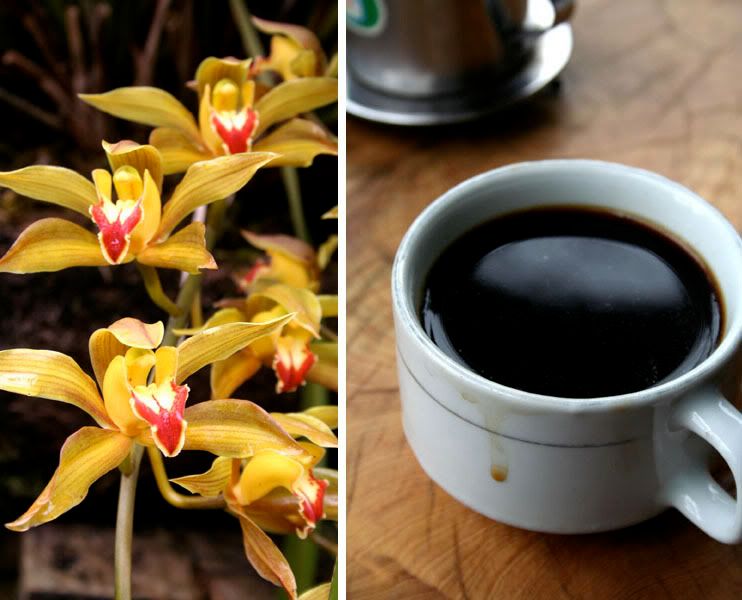 Even outside of Hanoi, coffee in Vietnam can bring some surprises. Looking over a menu in an orchid filled coffee garden in Sapa, we were confused by the listing of drip coffees identified only by the numbers 1 through 9. We enquired, and were informed that they were grades of coffee- Coffee #1 being the cheapest and also the most inferior, Coffee #9 being the best. We ordered two glasses of #9, and we weren’t disappointed. We were treated to two short mugs of unbelievably rich coffee. Blended with the sweet milk, it had a strong flavor of delicious dark chocolate.
Even outside of Hanoi, coffee in Vietnam can bring some surprises. Looking over a menu in an orchid filled coffee garden in Sapa, we were confused by the listing of drip coffees identified only by the numbers 1 through 9. We enquired, and were informed that they were grades of coffee- Coffee #1 being the cheapest and also the most inferior, Coffee #9 being the best. We ordered two glasses of #9, and we weren’t disappointed. We were treated to two short mugs of unbelievably rich coffee. Blended with the sweet milk, it had a strong flavor of delicious dark chocolate.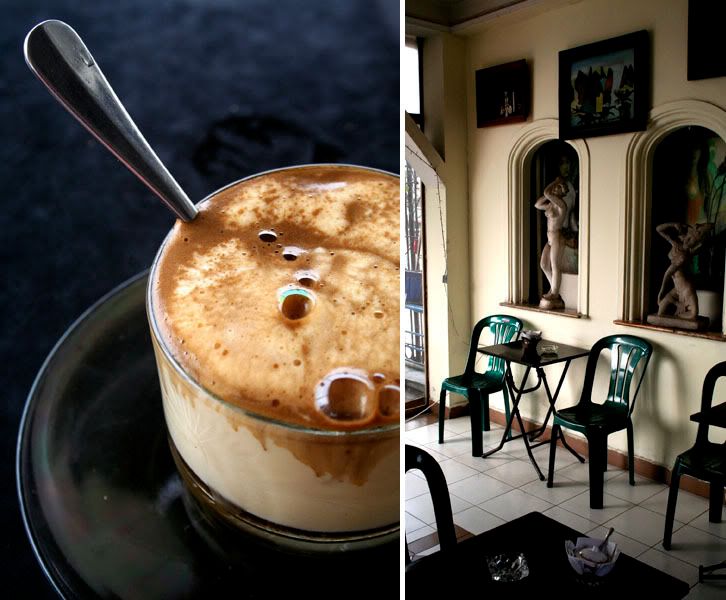 But drip coffee isn’t the only Vietnamese specialty. At Café Pho Co, a well-known Hanoi hole-in-the-wall with great views of the old quarter, Bordeaux ordered a mug of café trung. Its name, meaning ‘egg coffee,’ comes from the fact that it’s topped with a cap of whipped egg; it’s a local take on a cappuccino. Not only does the egg give the foam an impressively thick texture, it also adds an unbelievably rich creaminess, making every spoonful taste like an airy, coffee-tinted custard.
But drip coffee isn’t the only Vietnamese specialty. At Café Pho Co, a well-known Hanoi hole-in-the-wall with great views of the old quarter, Bordeaux ordered a mug of café trung. Its name, meaning ‘egg coffee,’ comes from the fact that it’s topped with a cap of whipped egg; it’s a local take on a cappuccino. Not only does the egg give the foam an impressively thick texture, it also adds an unbelievably rich creaminess, making every spoonful taste like an airy, coffee-tinted custard.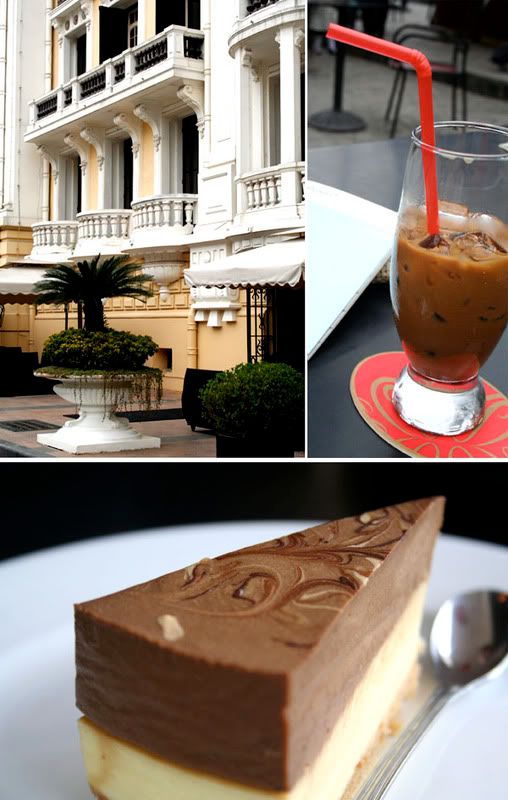 Perhaps best of all is the incredible variety of places in which to enjoy the flavorful local brew. With no Starbucks in the country, a local Vietnamese chain, Highlands coffee, has been able to flourish. Among the lattes and espressos on the menu, local drip coffee receives a prominent place. It also features in their pastry case, in the form of a Vietnamese coffee cheesecake. The bottom layer emulates the sweet condensed milk, while the top layer evokes the dark flavor of strong coffee. And best of all, these treats can be enjoyed in some outstanding locations. In Hanoi, you can sip Highlands coffee in a hip patio below the Opera House, among potted palms on a graceful deck looking over Hoan Kiem lake, or in a lush bamboo garden under the flag tower.
Perhaps best of all is the incredible variety of places in which to enjoy the flavorful local brew. With no Starbucks in the country, a local Vietnamese chain, Highlands coffee, has been able to flourish. Among the lattes and espressos on the menu, local drip coffee receives a prominent place. It also features in their pastry case, in the form of a Vietnamese coffee cheesecake. The bottom layer emulates the sweet condensed milk, while the top layer evokes the dark flavor of strong coffee. And best of all, these treats can be enjoyed in some outstanding locations. In Hanoi, you can sip Highlands coffee in a hip patio below the Opera House, among potted palms on a graceful deck looking over Hoan Kiem lake, or in a lush bamboo garden under the flag tower.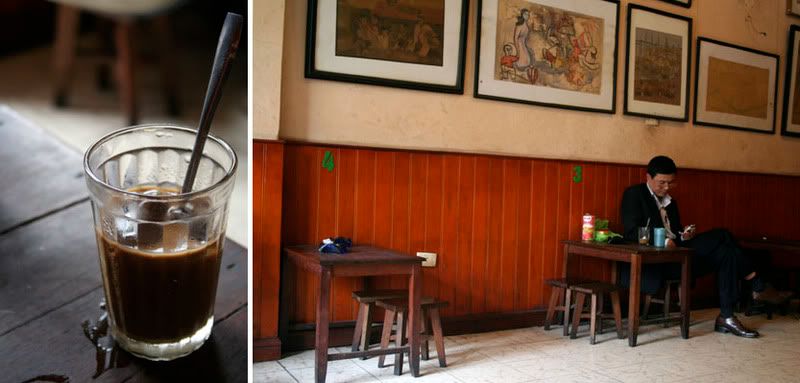 For a more distinctly Vietnamese experience, there are local cafes and coffee stands spilling onto most city sidewalks. Hanoi is packed with independent cafes, their names advertised in pastel hued awnings. They’re often very informal, with low tables on the edging out the door, and a few oil paintings scattered on bare white walls. Some, like Café Lam and Café Pho Co, have become institutions. However, you can get coffee that’s just as rich and flavorful at many of the lesser-known establishments.
For a more distinctly Vietnamese experience, there are local cafes and coffee stands spilling onto most city sidewalks. Hanoi is packed with independent cafes, their names advertised in pastel hued awnings. They’re often very informal, with low tables on the edging out the door, and a few oil paintings scattered on bare white walls. Some, like Café Lam and Café Pho Co, have become institutions. However, you can get coffee that’s just as rich and flavorful at many of the lesser-known establishments.Is it worth traveling abroad simply for the coffee? When the brew is as good as Vietnamese drip, the coffee shops as elegant as Highlands Coffee, and the streets as packed with independent cafes as Hanoi: certainly so.
Friday, April 25, 2008
LAndscapes: The Beverly Catalina Car Wash.
 One of the most distinctive features of the Los Angeles landscape is the stately carwash. Its sweeping block-long form sums up so much about Southern California- from the glamour of its oversized Spanish Mission style lanterns, to the angular Googie signage that seems so evocative of a post-war enthusiasm for the freedom of owning a private vehicle.
One of the most distinctive features of the Los Angeles landscape is the stately carwash. Its sweeping block-long form sums up so much about Southern California- from the glamour of its oversized Spanish Mission style lanterns, to the angular Googie signage that seems so evocative of a post-war enthusiasm for the freedom of owning a private vehicle.Photographed between Midtown and Korea-town, on Beverly and Catalina.
Themes:
California,
images,
L.A.ndscapes,
Los Angeles,
North America,
urban landscapes,
USA,
visualCULTURE
Thursday, April 24, 2008
Wednesday, April 23, 2008
Colors of the Nile Valley.
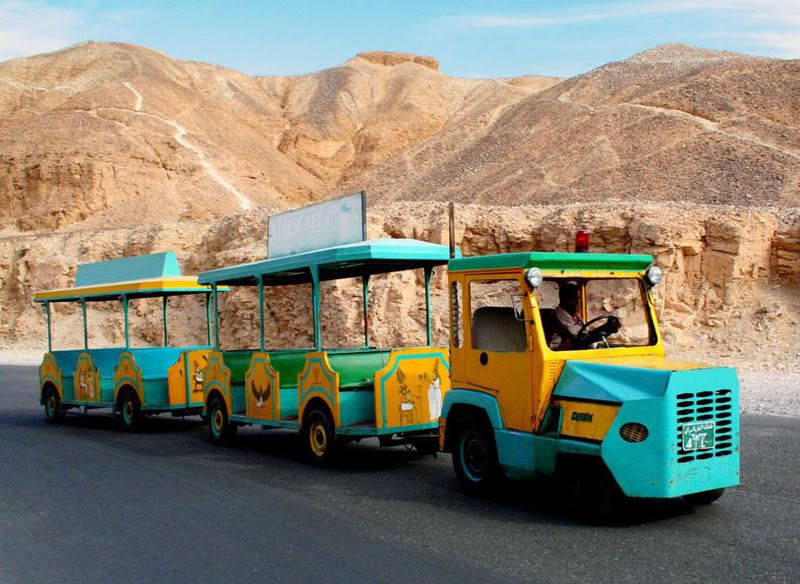 While working in a travel bookstore after college, I came to recognize different countries by their colors. We sold a large selection of glossy hard-cover books, and all the books on a particular country seemed to come in a distinctive color: China was red, both for communist propaganda and Imperial grandeur; Uganda was green for lush jungles and flooded plains; and Egypt was a lifeless sandstone, for sunburnt desert and wind bitten ruins. With these khaki book-bingings in mind, I arrived in Egypt expecting a landscape leeched by the sun of color. But looking out the window as my train rumbled toward Aswan, I was confronted by a glittering landscape of fields dripping neon green, and houses painted in pastel hues.
While working in a travel bookstore after college, I came to recognize different countries by their colors. We sold a large selection of glossy hard-cover books, and all the books on a particular country seemed to come in a distinctive color: China was red, both for communist propaganda and Imperial grandeur; Uganda was green for lush jungles and flooded plains; and Egypt was a lifeless sandstone, for sunburnt desert and wind bitten ruins. With these khaki book-bingings in mind, I arrived in Egypt expecting a landscape leeched by the sun of color. But looking out the window as my train rumbled toward Aswan, I was confronted by a glittering landscape of fields dripping neon green, and houses painted in pastel hues.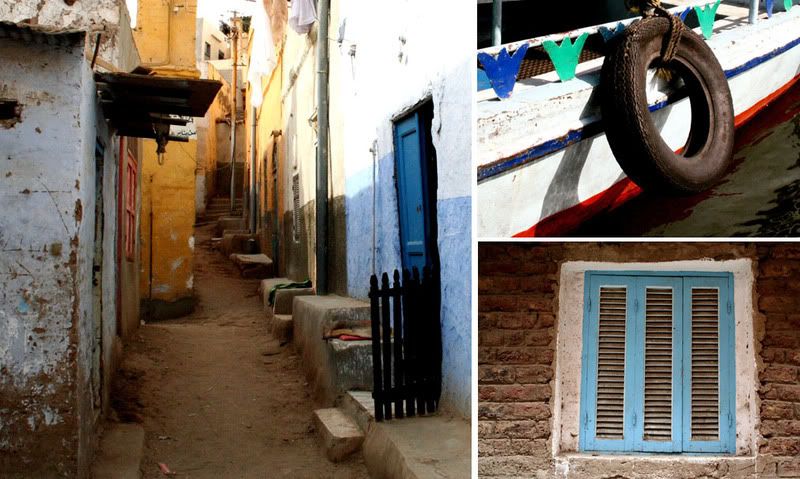

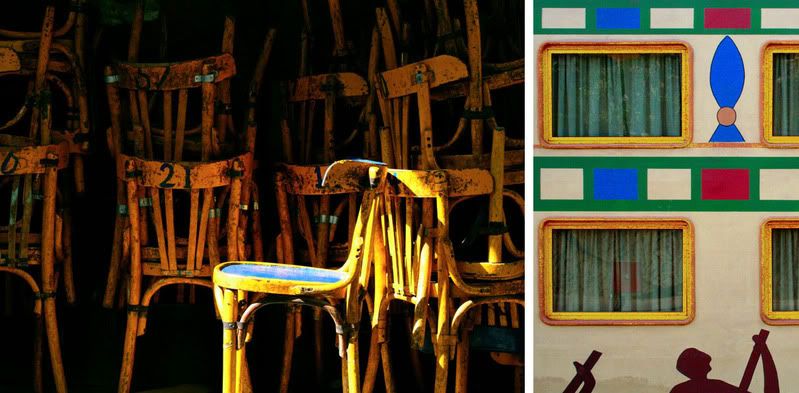

Themes:
Africa,
colors,
Egypt,
Middle East,
visualCULTURE
Tuesday, April 22, 2008
100 pots of curry.
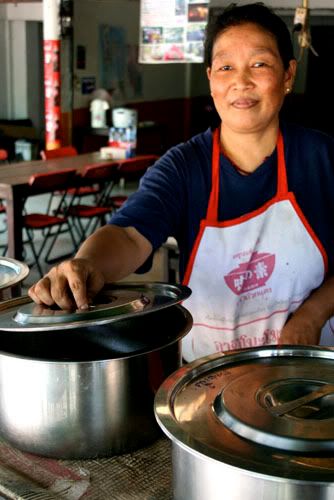 The Mon people who live along Thailand's border with Burma are known for making a greater variety of curry than any other group in the country. One of the most well known places to sample a few is in the town of Thong Pha Poom, a quiet stopping point for buses and trucks travelling between Kanchanaburi and Sangklaburi. Just outside of town, along route 323, is the highway-side shop named Rawy Maw, meaning One-hundred Pots. On our visit, they were just short of 100 pots- they had about thirteen. We ordered two plates, and the proprietress spooned heaps of different curries onto the two mounds of rice. Thanks to a basic vocabulary of Thai food words, we were able to pick out an interesting selection. We tried fiery red curry with fish; yellow chicken curry with hot basil and tiny egpplants; a chunky paneang curry with pork; sour curry with pickled bamboo; and a green curry laden with sliced chillies. Though the meal was tasty, admittedly no curry was outstanding or exceptional. Even so, it was interesting to see what a range of flavors, textures and tastes curries can have.
The Mon people who live along Thailand's border with Burma are known for making a greater variety of curry than any other group in the country. One of the most well known places to sample a few is in the town of Thong Pha Poom, a quiet stopping point for buses and trucks travelling between Kanchanaburi and Sangklaburi. Just outside of town, along route 323, is the highway-side shop named Rawy Maw, meaning One-hundred Pots. On our visit, they were just short of 100 pots- they had about thirteen. We ordered two plates, and the proprietress spooned heaps of different curries onto the two mounds of rice. Thanks to a basic vocabulary of Thai food words, we were able to pick out an interesting selection. We tried fiery red curry with fish; yellow chicken curry with hot basil and tiny egpplants; a chunky paneang curry with pork; sour curry with pickled bamboo; and a green curry laden with sliced chillies. Though the meal was tasty, admittedly no curry was outstanding or exceptional. Even so, it was interesting to see what a range of flavors, textures and tastes curries can have.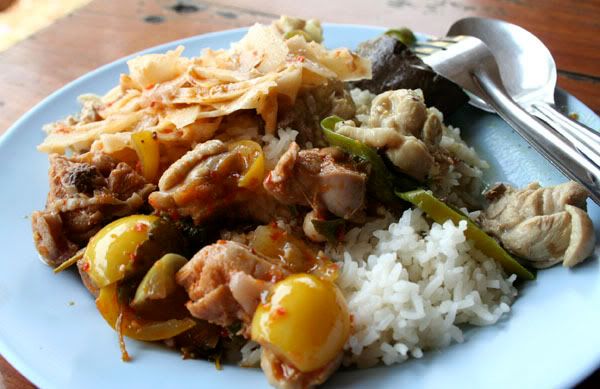
Monday, April 21, 2008
The city you lived in is ugly: L.A.ndscapes.
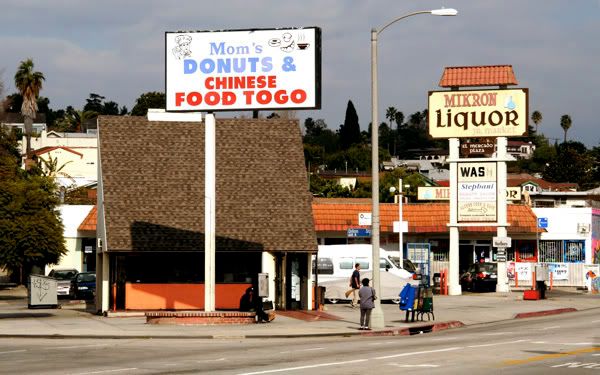 When I tell people that I lived in LA, they frequently show no hesitation in informng me how much they hate the city. Perhaps they expect that I'll feel the same because it isn't my place of origin or because I chose to leave, or maybe they don't care what I think about it, but it always seems a little tacky to me. I love LA, so I have to admit I do feel a little offended when I hear that. I certainly don't expect everyone to like Los Angeles: I know of course that tastes and preferences vary, and that people have legitimate reasons for disliking LA. But it often seems that people simply repeat the sentiment without good reason, as if to dislike 'Hollywood' is a rejection of the qualities associated with it. And those qualities attached to LA, that it's vacuous, unintellectual, and shallow, strike me as a hollow cliche.
When I tell people that I lived in LA, they frequently show no hesitation in informng me how much they hate the city. Perhaps they expect that I'll feel the same because it isn't my place of origin or because I chose to leave, or maybe they don't care what I think about it, but it always seems a little tacky to me. I love LA, so I have to admit I do feel a little offended when I hear that. I certainly don't expect everyone to like Los Angeles: I know of course that tastes and preferences vary, and that people have legitimate reasons for disliking LA. But it often seems that people simply repeat the sentiment without good reason, as if to dislike 'Hollywood' is a rejection of the qualities associated with it. And those qualities attached to LA, that it's vacuous, unintellectual, and shallow, strike me as a hollow cliche.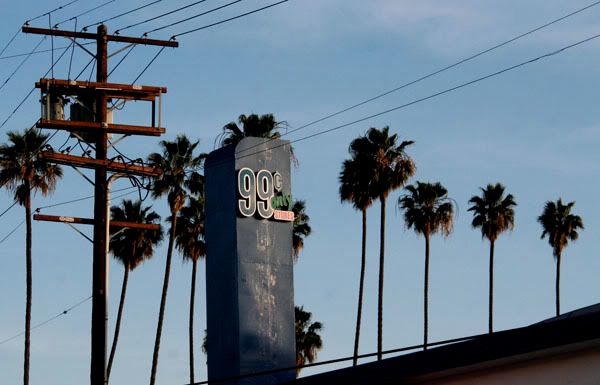 I find LA to be a vibrant, exciting city; it's a centre for progressive art and design, and a cosmopolitan mingling of diverse cultures. Beyond that- and this is where many disagree with me- I think that it's simply a beautiful city to look at. Then again, I'm not much helping that cause. Exactly one year ago, I started this blog with my first photographic entry, a piece about photographing Hollywood, which was written in and about Los Angeles. However, in the year that's followed, I've only written six more entries devoted entirely to the city. I have hundreds of photographs of LA, but I've probably published less than thirty of them on Primitive Culture. So I'm starting a new series: L.A.ndscapes. I'll be combining urban photographs with stories, pieces of history, or tips for traveling in the city of angels. I don't expect to change anyones mind about Los Angles- but I hope to at least show why I love it.
I find LA to be a vibrant, exciting city; it's a centre for progressive art and design, and a cosmopolitan mingling of diverse cultures. Beyond that- and this is where many disagree with me- I think that it's simply a beautiful city to look at. Then again, I'm not much helping that cause. Exactly one year ago, I started this blog with my first photographic entry, a piece about photographing Hollywood, which was written in and about Los Angeles. However, in the year that's followed, I've only written six more entries devoted entirely to the city. I have hundreds of photographs of LA, but I've probably published less than thirty of them on Primitive Culture. So I'm starting a new series: L.A.ndscapes. I'll be combining urban photographs with stories, pieces of history, or tips for traveling in the city of angels. I don't expect to change anyones mind about Los Angles- but I hope to at least show why I love it.
Themes:
California,
images,
L.A.ndscapes,
Los Angeles,
North America,
urban landscapes,
USA,
visualCULTURE
Wednesday, April 16, 2008
around town/bangkok: Vanilla Garden.
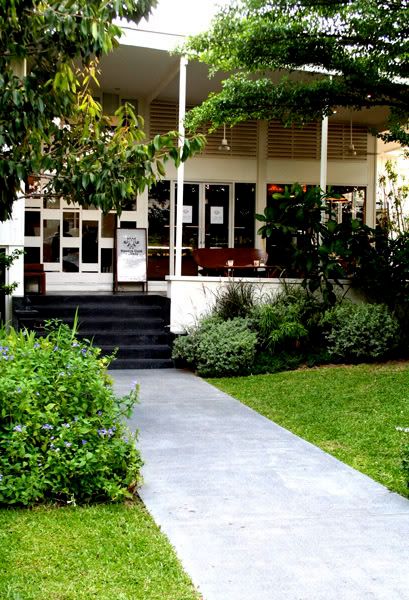 Scattered throughout Bangkok's moneyed neighborhoods, Vanilla outlets act as sanctuaries of domestic charm. Step in from the pavement or the crowded mall, and be treated to creamy lattes and decadent baked goods. Every aspect of Vanilla is perfectly styled, from the rich-as-chocolate interiors to the flour-dusted uniforms of the wait staff, making it the ideal setting for an afternoon escape. Vanilla Garden takes the idea of a retreat one step further. Located some distance down Ekkamai Soi 12, it's the most obscure branch, and the only one not designed to be approached by foot traffic. But step in through the garden gate, and you'll quickly forget the cab fare it took to get there.
Scattered throughout Bangkok's moneyed neighborhoods, Vanilla outlets act as sanctuaries of domestic charm. Step in from the pavement or the crowded mall, and be treated to creamy lattes and decadent baked goods. Every aspect of Vanilla is perfectly styled, from the rich-as-chocolate interiors to the flour-dusted uniforms of the wait staff, making it the ideal setting for an afternoon escape. Vanilla Garden takes the idea of a retreat one step further. Located some distance down Ekkamai Soi 12, it's the most obscure branch, and the only one not designed to be approached by foot traffic. But step in through the garden gate, and you'll quickly forget the cab fare it took to get there.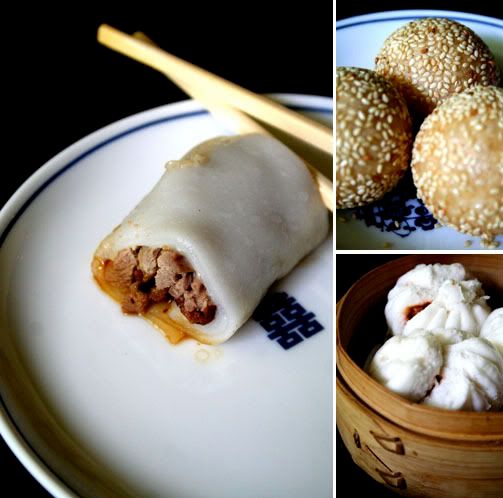 Vanilla Garden is actually a complex, uniting three distinct shops in one lush garden. Where other Vanilla locations reflect European tastes, the offerings at Vanilla Garden are distinctly East Asian. There's Royal Vanilla, a retro dim sum and tea house; Vanilla Cafe, a midcentury Japanese style coffee house; and Sauce, a sleek two-floor bookstore. We arrived for a late lunch, and found the grounds buzzing, but not busy. Though the bento boxes and living-room style setting of Vanilla Cafe looked inviting, we were tempted instead by the menu at Royal Vanilla. With dark furnishings and carved wooden screens, the small interior of Royal Vanilla is meant to evoke 1920s China. The large glass windows facing onto the garden make it a particularly attractive setting. The selection of dim sum was good, if not overly extensive- we opted for several dishes, including red bean sesame balls, steamed pork buns, and Shanghai style dumplings. Though all of the dishes were brilliant, the highlights were a wrapped noodle filled with flavorful duck meat, and the lotus steamed sticky rice. Refreshments were just as interesting as the food, and included not only tea, but drinks like plum soda and soy-milk with ginger.
Vanilla Garden is actually a complex, uniting three distinct shops in one lush garden. Where other Vanilla locations reflect European tastes, the offerings at Vanilla Garden are distinctly East Asian. There's Royal Vanilla, a retro dim sum and tea house; Vanilla Cafe, a midcentury Japanese style coffee house; and Sauce, a sleek two-floor bookstore. We arrived for a late lunch, and found the grounds buzzing, but not busy. Though the bento boxes and living-room style setting of Vanilla Cafe looked inviting, we were tempted instead by the menu at Royal Vanilla. With dark furnishings and carved wooden screens, the small interior of Royal Vanilla is meant to evoke 1920s China. The large glass windows facing onto the garden make it a particularly attractive setting. The selection of dim sum was good, if not overly extensive- we opted for several dishes, including red bean sesame balls, steamed pork buns, and Shanghai style dumplings. Though all of the dishes were brilliant, the highlights were a wrapped noodle filled with flavorful duck meat, and the lotus steamed sticky rice. Refreshments were just as interesting as the food, and included not only tea, but drinks like plum soda and soy-milk with ginger. After lunch, we leafed through hardcovers in Sauce. Though there are a fair number of cookbooks among the dark wooden shelves, the store seems to concentrate on style and architecture-- in fact, it has one of the best selections of design books in Bangkok. We found books on California interiors, Calcutta cooking, and Chinese product design. In addition, it offers a small rane of Vanilla brand products, like funky aprons, stylish shopping bags, and dessert-scented handwash.
After lunch, we leafed through hardcovers in Sauce. Though there are a fair number of cookbooks among the dark wooden shelves, the store seems to concentrate on style and architecture-- in fact, it has one of the best selections of design books in Bangkok. We found books on California interiors, Calcutta cooking, and Chinese product design. In addition, it offers a small rane of Vanilla brand products, like funky aprons, stylish shopping bags, and dessert-scented handwash. By the time we'd browsed through a dozen books on Vietnamese cuisine and tropical Asian architecture, we were ready for a latte at Vanilla Cafe. Housed in a refurbished 1960s home, Vanilla Cafe serves as the focal point of the garden complex. As attractive as the house itself is, the interior is even more striking, with mod Japanese furnishings, and bookshelves stacked with brightly colored comics books and plastic toys. The coffee menu is similar to other Vanilla outlets, but it also includes a long list smoothies and shakes, like red bean or nutella frappes. The dessert menu also covers a mix of Vanilla standards and Japanese treats, with banoffee cakes sharing shelf-spaces with dorayaki and mochi. After ordering a the counter, we took our lattes and brownie out onto the front porch, where two wooden benches were positioned to face the garden and the splashing fountain. It was the ideal spot to sit back, sip our lattes, and appreciate the escapist haven that is Vanilla Garden.
By the time we'd browsed through a dozen books on Vietnamese cuisine and tropical Asian architecture, we were ready for a latte at Vanilla Cafe. Housed in a refurbished 1960s home, Vanilla Cafe serves as the focal point of the garden complex. As attractive as the house itself is, the interior is even more striking, with mod Japanese furnishings, and bookshelves stacked with brightly colored comics books and plastic toys. The coffee menu is similar to other Vanilla outlets, but it also includes a long list smoothies and shakes, like red bean or nutella frappes. The dessert menu also covers a mix of Vanilla standards and Japanese treats, with banoffee cakes sharing shelf-spaces with dorayaki and mochi. After ordering a the counter, we took our lattes and brownie out onto the front porch, where two wooden benches were positioned to face the garden and the splashing fountain. It was the ideal spot to sit back, sip our lattes, and appreciate the escapist haven that is Vanilla Garden. Why: It's worth the trip for delicious dim sum, tasty bento boxes, or decadent desserts in a relaxing and flawlessly-styled garden setting.
Why: It's worth the trip for delicious dim sum, tasty bento boxes, or decadent desserts in a relaxing and flawlessly-styled garden setting.Where: #53 Ekkamai Soi 12. It's a fair distance from the Ekkamai BTS terminal, so it's advisable to either take a bus to Soi 12, or a taxi from the BTS terminal.
When: Officially open 11:00 to 23:00, but they may actually close at 22:00.
How much: Prices are moderately high for Bangkok, but well worth it. Dim sum plates from 50B, main dishes at both restaurants range from about 180-300B. Coffee drinks average 80-90B, smoothies and shakes are roughly double that. Desserts range from about 40B for a peanut-butter brownie to 90B for more elaborate cakes.
Themes:
around town,
Bangkok,
Southeast Asia,
Thailand,
urbanPRIMITIVE
Monday, April 14, 2008
Friday, April 11, 2008
Bangkok Colors: White.
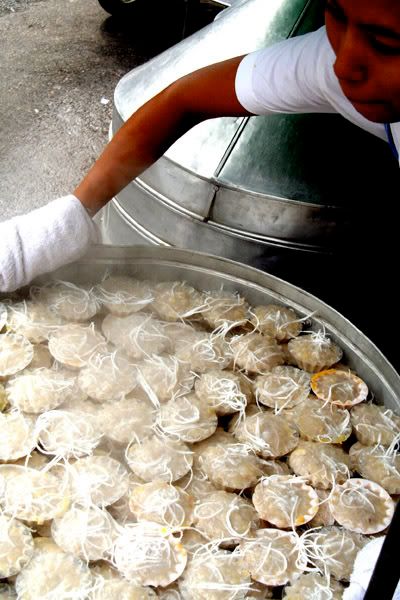 Sitting on the subway one afternoon, my eyes passed over three ladies dressed from head-to-heel in white. At first, I took them as three Buddhist nuns, with shaved heads and austere white robes. With a bit of surprise, I realized that only the first two were nuns: the third was a lavishly styled Hi-So woman, wearing a white silk suit, a massive white purse, and glamorously oversized white glasses. Ordinarily, white isn't a color I connect with Thailand (where every day of the week has its own color), or Bangkok (where pollution and pastel-paint coat every building). But upon looking back on these three women, I realized the degree to which white reflects two disparate sides of the Thai capital. White is a color of purity and austerity, but it's also a color of luxury and refinement. It's visible in the folded lotus buds at a shrine, or the porcelain tea sets of an elegant cafe; it shines in the hallowed walls of a grand Buddhist temple, and in the columns of the Erawan's temple to commerce.
Sitting on the subway one afternoon, my eyes passed over three ladies dressed from head-to-heel in white. At first, I took them as three Buddhist nuns, with shaved heads and austere white robes. With a bit of surprise, I realized that only the first two were nuns: the third was a lavishly styled Hi-So woman, wearing a white silk suit, a massive white purse, and glamorously oversized white glasses. Ordinarily, white isn't a color I connect with Thailand (where every day of the week has its own color), or Bangkok (where pollution and pastel-paint coat every building). But upon looking back on these three women, I realized the degree to which white reflects two disparate sides of the Thai capital. White is a color of purity and austerity, but it's also a color of luxury and refinement. It's visible in the folded lotus buds at a shrine, or the porcelain tea sets of an elegant cafe; it shines in the hallowed walls of a grand Buddhist temple, and in the columns of the Erawan's temple to commerce.
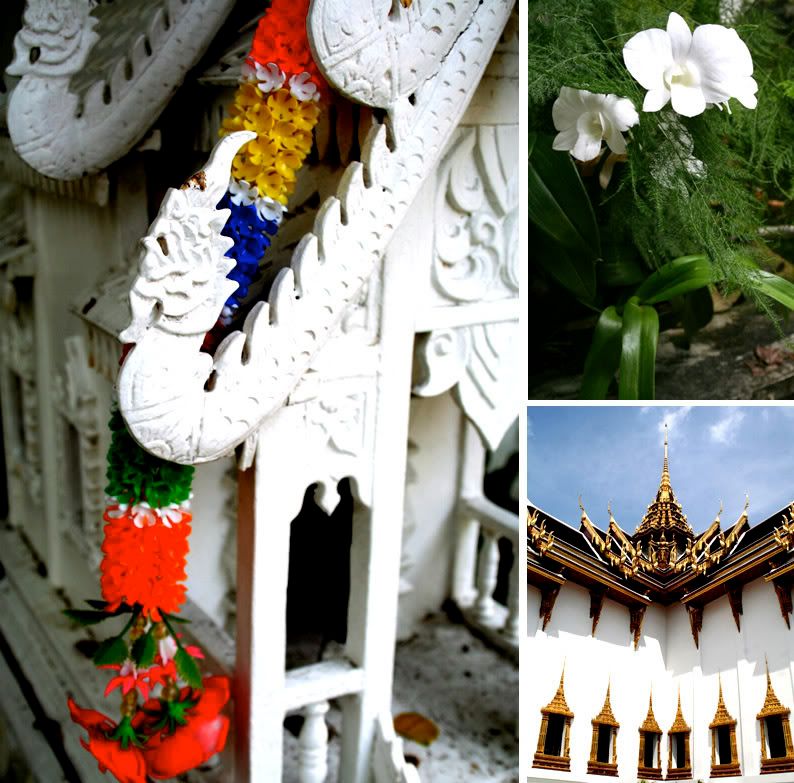

Themes:
Bangkok,
Bangkok Colors,
colors,
Southeast Asia,
Thailand,
visualCULTURE
Wednesday, April 09, 2008
In bloom on my soi.
 Despite being a lane off of Bangkok's busiest road, my soi has the atmosphere of a rural Thai village. Every morning a woman sets up a charcoal grill, and by the time I set out for work the air is smoking with the delicious scent of roasting fish and barbecued chicken. Men and women gather on the shaded wooden benches, chatting, playing checkers, or taking naps in the mid-morning heat. As the temperatures of the dry season have risen, the dok khun tree above this soi has exploded with draping yellow flowers, making the setting more exotic than ever.
Despite being a lane off of Bangkok's busiest road, my soi has the atmosphere of a rural Thai village. Every morning a woman sets up a charcoal grill, and by the time I set out for work the air is smoking with the delicious scent of roasting fish and barbecued chicken. Men and women gather on the shaded wooden benches, chatting, playing checkers, or taking naps in the mid-morning heat. As the temperatures of the dry season have risen, the dok khun tree above this soi has exploded with draping yellow flowers, making the setting more exotic than ever.*This post was inspired by an entry on the same tree at bloom in Laos, on the wonderful blog Mekong River Tributaries.
Monday, April 07, 2008
Friday, April 04, 2008
View of Lion's Head #6.
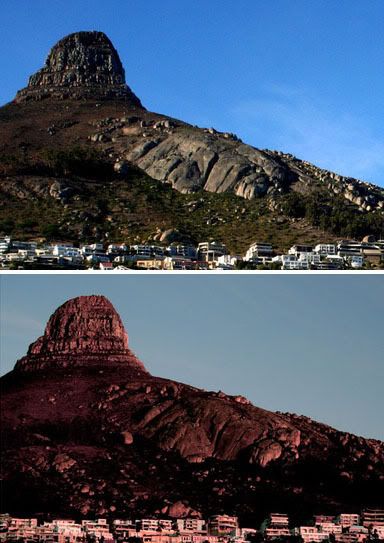 Now that my life is briefly back on a routine schedule, I can resume some long neglected series. With my thoughts on the Cape lately, I felt I should start off with another View of Lion's Head. Leaving my apartment in the morning and returning in the evening, I was often witness to the transformative effect sunlight had on the old hill. From a fully revealed rocky outcropping, it would develop an exotic glow in the bleeding shades of sunset.
Now that my life is briefly back on a routine schedule, I can resume some long neglected series. With my thoughts on the Cape lately, I felt I should start off with another View of Lion's Head. Leaving my apartment in the morning and returning in the evening, I was often witness to the transformative effect sunlight had on the old hill. From a fully revealed rocky outcropping, it would develop an exotic glow in the bleeding shades of sunset.
Themes:
Africa,
Cape Town,
Lion's Head,
South Africa
Wednesday, April 02, 2008
A peek at Phuket.
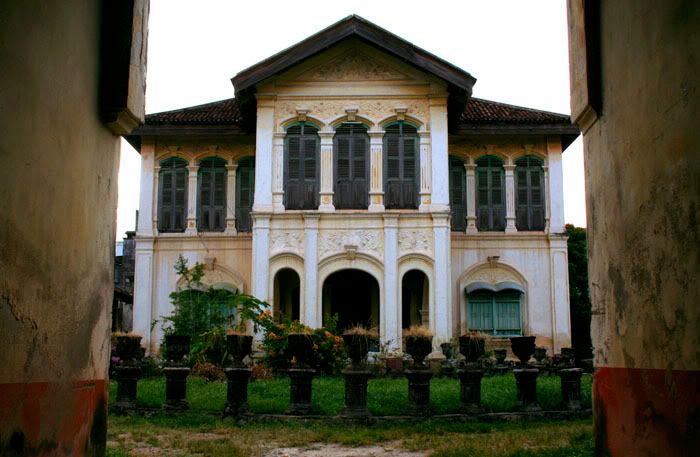 Phuket tends to get a bad rap. As one of the most visited destinations in Thailand, it gets discounted as being too commercialized, too developed. Yet at the end of our trip to Southern Thailand, our flight connections required that we spend a little time in Phuket. Despite my expectations, I found that Phuket Town is surprisingly charming and intriguing. Streets were lined in old-fashioned shop-fronts that appeared to have been decorated using all the paints in the watercolor box. Inviting spicy scents lingered from sidewalk canteens; discreet alleys concealed elegant mansions, anonymous shop-houses hid plush boutiques and elegant cafes. We were only there for a few hours, but I definitely think I'll have to return soon to explore more.
Phuket tends to get a bad rap. As one of the most visited destinations in Thailand, it gets discounted as being too commercialized, too developed. Yet at the end of our trip to Southern Thailand, our flight connections required that we spend a little time in Phuket. Despite my expectations, I found that Phuket Town is surprisingly charming and intriguing. Streets were lined in old-fashioned shop-fronts that appeared to have been decorated using all the paints in the watercolor box. Inviting spicy scents lingered from sidewalk canteens; discreet alleys concealed elegant mansions, anonymous shop-houses hid plush boutiques and elegant cafes. We were only there for a few hours, but I definitely think I'll have to return soon to explore more.
Themes:
Southeast Asia,
Thai Islands and Beaches,
Thailand
Subscribe to:
Posts (Atom)

